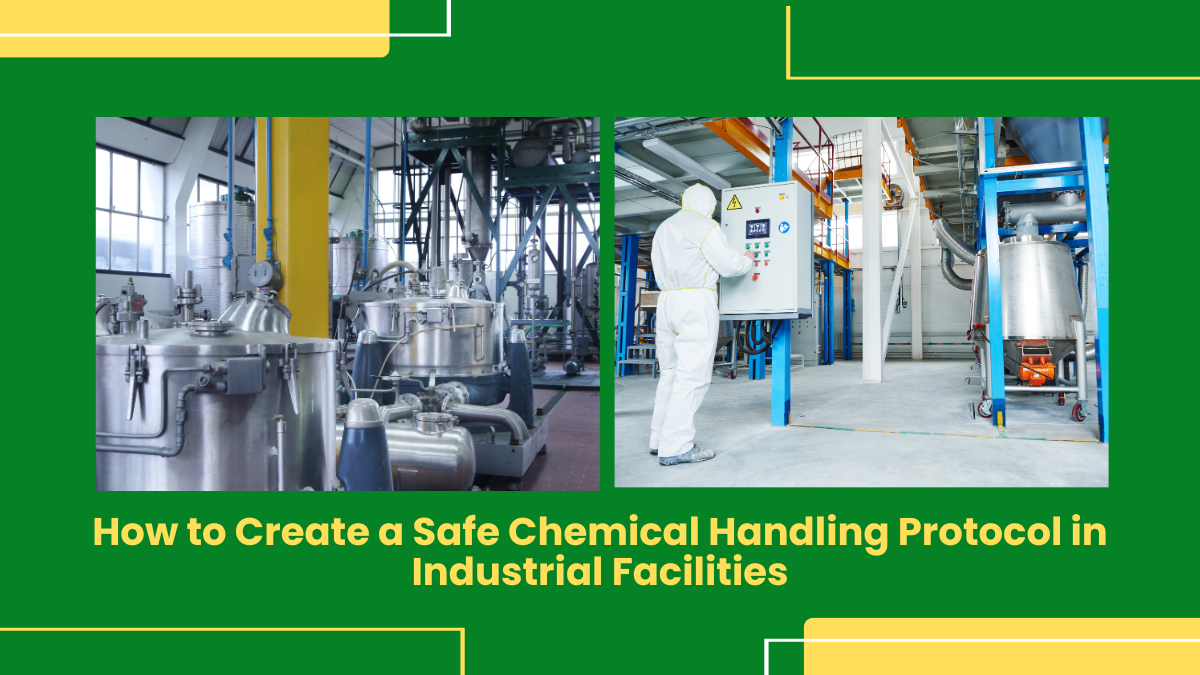Introduction
Handling Safe chemicals in industrial settings brings unique challenges. From storage and transport to everyday use on the shop floor, mishandling can lead to health hazards, environmental damage, regulatory penalties, and costly downtime. A well-designed chemical handling protocol serves as the backbone of any safety program, ensuring consistent practices, clear communication, and rapid response in emergencies.
This guide explores common problems that arise in Safe Chemical handling, offers practical solutions for each, and provides prevention tips to keep your facility running smoothly. We’ll also show how Ecochem’s simple digital signage platform—integrating with over 100 applications—can help you deliver real-time safety alerts, display up-to-date procedures, and reinforce a culture of “Safe Chemical Handling” across every shift.
Problems
1. Inconsistent Labeling and Documentation
Challenge: When containers arrive without proper labels or with outdated information, workers lack critical details about hazards, protective measures, and handling limits. Misreading or missing data increases the risk of chemical exposure, incompatible mixing, and improper disposal.
Impact:
- Increased incidents of accidental spills or reactions
- Difficulty verifying compliance with GHS (Globally Harmonized System) standards
- Delayed emergency response due to missing Safety Data Sheets (SDS)
2. Insufficient Engineering and Administrative Controls
Challenge: Without adequate containment, ventilation, or procedural controls, chemicals can escape into the work environment. Over time, low-level exposure accumulates, leading to chronic health issues among staff.
Impact:
- Elevated airborne concentrations beyond permissible exposure limits (PELs)
- Frequent minor leaks and drips that go unnoticed
- Inconsistent use of fume hoods or local exhaust ventilation
3. Gaps in Employee Training
Challenge: Formal training programs may skip essential topics such as hazard communication, the correct use of PPE, or spill response steps. When workers rely on memory rather than standardized instructions, inconsistencies arise.
Impact:
- Incorrect selection or use of personal protective equipment
- Delayed recognition of exposure symptoms
- Inadequate response to minor leaks or splashes
4. Poor Emergency Preparedness
Challenge: Emergency plans that lack drills tailored to specific chemicals or omit coordination with local first responders leave teams unready when incidents occur. Outdated contact lists, missing spill kits, or unclear evacuation routes can turn a small leak into a major crisis.
Impact:
- Longer response times during spills or fires
- Confusion in evacuation procedures
- Increased severity of incidents and potential injuries
5. Fragmented Communication
Challenge: Relying solely on paper binders or outdated bulletin boards means critical updates, like revised SDSs or new emergency contacts, often go unnoticed until it’s too late.
Impact:
- Workers using superseded procedures
- Missed notifications about maintenance outages or system failures
- Difficulty verifying that all shifts received the latest safety alerts
Solutions
1. Develop Comprehensive Standard Operating Procedures (SOPs)
Action Steps:
- Inventory hazards: List each Safe Chemical, its properties, and hazard classification.
- Detailed handling steps: Describe receipt, transfer, storage, usage, and disposal processes.
- Specify engineering and administrative controls: Note required ventilation, secondary containment, supervisor approvals, and rotation schedules.
- Include emergency steps: Outline spill response, first-aid measures, and escalation contacts.
Ecochem Integration: Display each SOP on digital signage at relevant workstations. When updates occur, such as a revised handling step, Ecochem syncs automatically with your document management system, ensuring everyone sees the latest version.
2. Enforce Rigorous Labeling and SDS Management
Action Steps:
- Apply GHS-compliant labels immediately upon receipt of chemicals.
- Maintain both printed and digital SDS libraries, with tablets or touchscreens in storage areas.
- Assign a document custodian responsible for tracking SDS revisions and distributor updates.
Ecochem Integration: Safe Chemical-Link SDS documents to Ecochem. Workers scan a QR code on the container and instantly view the current SDS on nearby displays. If an SDS changes, Ecochem pushes an alert, prompting responsible staff to reprint labels.
3. Implement Engineering Controls
Action Steps:
- Install local exhaust ventilation (LEV) at transfer points and reaction vessels.
- Use enclosed transfer systems or glove boxes for hazardous or volatile chemicals.
- Deploy continuous monitoring sensors for leaks or elevated vapor concentrations.
Ecochem Integration: Integrate sensor outputs with Ecochem. Safe Chemical. If a sensor detects a threshold breach, Ecochem issues on-screen warnings and can automatically trigger audible alerts in the affected zone.
4. Establish Administrative Controls
Action Steps:
- Rotate personnel in high-exposure tasks to limit cumulative dose.
- Implement work/rest cycles in areas with intermittent exposures.
- Require pre-shift checklists verifying PPE, tool readiness, and hazard signs.
Ecochem Integration: Safe Chemical Use Ecochem’s scheduling integration (e.g., with SAP or Kronos) to display daily rotation schedules, checklist reminders, and break timers directly on shop-floor screens.
5. Provide Targeted Training and Competency Assessments
Action Steps:
- Create modular training covering general chemical safety, job-specific hazards, and emergency protocols.
- Incorporate hands-on drills for donning respirators or executing spill responses.
- Use competency quizzes to verify understanding and track progress.
Ecochem Integration: Load training modules and short videos onto Ecochem. Schedule them to play on break-room screens or at shift-start. Embed quick quizzes; workers tap answers on touchscreen displays. Results feed back to your LMS (Learning Management System) for compliance tracking.
6. Conduct Regular Audits and Inspections
Action Steps:
- Schedule weekly walkthroughs focusing on labeling, storage conditions, and PPE availability.
- Use standardized digital checklists to capture observations in real time.
- Follow up on findings with action items, assigning responsibility and deadlines.
Ecochem Integration: Safe Chemical- Present audit checklists directly on shop-floor monitors. Inspectors tick items on touchscreens; Ecochem compiles reports and can email summaries to managers immediately.
7. Strengthen Emergency Preparedness
Action Steps:
- Update emergency plans for each major chemical category (acids, bases, solvents, oxidizers).
- Stock spill kits customized for common chemical types and place them at key locations.
- Coordinate drills quarterly, involving facility personnel, maintenance, and local first responders.
Ecochem Integration: Safe Chemical Broadcast drill announcements, evacuation maps, and muster-point directions on screens facility-wide. During drills, Ecochem can display timers and progress bars to keep participants on schedule.
Prevention Tips
1. Maintain Equipment and Infrastructure
- Preventive Maintenance: Schedule routine service for ventilation fans, pumps, and valves.
- Calibration: Verify sensor accuracy on leak-detection systems at regular intervals.
- Housekeeping: Keep floors clear of drips and debris; immediately clean small spills.
Ecochem Reminder: Show upcoming maintenance tasks and calibration due dates on dashboards across the plant.
2. Optimize Chemical Inventory and Vendor Management
- Just-In-Time Inventory: Order only the volume needed for current production runs.
- Approved Vendor List: Work with suppliers who provide consistent quality and complete documentation.
- Shelf-Life Tracking: Label containers with receipt and expiration dates.
Ecochem Alerting: Integrate with procurement tools (e.g., Oracle, Microsoft Dynamics) so Ecochem notifies purchasing teams when stocks run low or approach expiry.
3. Transition to Safer Alternatives
- Hazard Analysis: Regularly review processes to identify opportunities for substitution.
- Pilot Testing: Evaluate performance and compatibility before full-scale adoption.
- Stakeholder Buy-In: Involve operators, maintenance, and EHS teams in selection.
Ecochem Announcement: Roll out substitution initiatives via email and on-site digital signage. Show comparative hazard data (e.g., toxicity, flammability) to build awareness.
4. Drill Emergency Response Scenarios
- Role-Playing: Assign specific roles (incident commander, first response team, evacuation warden).
- Realistic Conditions: Use water or harmless simulants to practice spill containment.
- Debriefing: Record lessons learned and update procedures accordingly.
Ecochem Drill Mode: When a drill starts, Ecochem switches to “Emergency” layout—displaying response steps, contact lists, and drill timers until exercises conclude.
5. Foster a Safety-First Culture
- Near-Miss Reporting: Encourage voluntary submission of close-call incidents without penalty.
- Recognition Programs: Highlight individuals or teams who identify hazards.
- Open Feedback: Hold monthly safety meetings to discuss concerns and improvements.
Ecochem Shoutouts: Install a “Safety Wall” screen that rotates near-miss stories, positive safety metrics, and team recognitions in real time.
6. Continuous Improvement through Data Analytics
- Centralized Database: Log incidents, audit findings, sensor readings, and training results in one system.
- Trend Analysis: Identify recurring issues, such as leaks in a specific area or repeated PPE violations.
- Protocol Refinement: Update SOPs and controls based on data insights.
Cleaning Calls For Eco-Met Tap Shinner For Cleaning Heavy Metals And Tools
Metals are malleable and ductile and hence are of great advantage to humankind. With high tensile strength, metals like iron and alloys are used to make heavy machinery, and automobiles have a great value to many sectors. One of the weaknesses is that they corrode when coming in contact with water and air. To resist and postpone metallic corrosion, Ecochem has formulated Eco-Met Tap Shinner. A non-toxic bio-based cleaning product to clean the rust and hard water stains to save it from further damage.
Hands Fresh With Eco-Green Fresh!
Eco-Green Fresh is the ideal green hand wash made out of specialized herbs and natural cleansers to take care of the hands and skin. With complete precision and dedication, Ecochem researchers have finally formulated a solution for hands that are always in working mode. The unique formula of green chemical for hand wash is the safest way that drives long-lasting, multi-purpose, perfumed cleanser for hands.
Ecochem Dashboards: Create live dashboards showing key performance indicators (KPIs) like days since last incident, average response time, and current air quality indices. Place them at supervisory stations and common areas.
Bringing It All Together
A robust Safe Chemical Handling protocol combines clear procedures, reliable controls, ongoing training, and a culture that values safety above all. By integrating Ecochem’s digital signage platform, which connects securely to over 100 applications, you ensure that every update, alert, and piece of safety information reaches the right people at the right time. Whether it’s a revised SOP, a sensor alarm, an upcoming drill, or a team’s safety achievement, Ecochem displays it instantly across your facility, reinforcing best practices and keeping chemical risks under control. Implement these problem-solving strategies and prevention tips to build a lasting “Safe Chemical Handling” program. With diligent planning, regular reviews, and powerful digital communications, your industrial facility can maintain compliance, protect employees, and drive continuous improvement without ever compromising on productivity or operational efficiency.
FAQ’S
What is safe chemical handling?
Safe chemical handling involves proper labeling, storage, PPE, SOP adherence, emergency preparedness, and training to minimize exposure in industrial settings.
How often should SOPs be updated?
Update SOPs annually or when processes change; ensure digital signage reflects current procedures and staff acknowledge all updates immediately on-screen.
What PPE is required?
PPE depends on chemical hazards: gloves, goggles, respirators, protective clothing, and footwear; consult SDS, OSHA guidelines, and local exposure limits.
How are spills handled?
Activate alarms, don PPE, contain and neutralize the spill, collect waste in labeled containers immediately, report the incident, and follow emergency procedures.
How often train employees?
Provide initial training before chemical duties, then annual refreshers, plus quarterly toolbox talks and sessions upon procedural or material changes.
Written By: Vinny Jain


